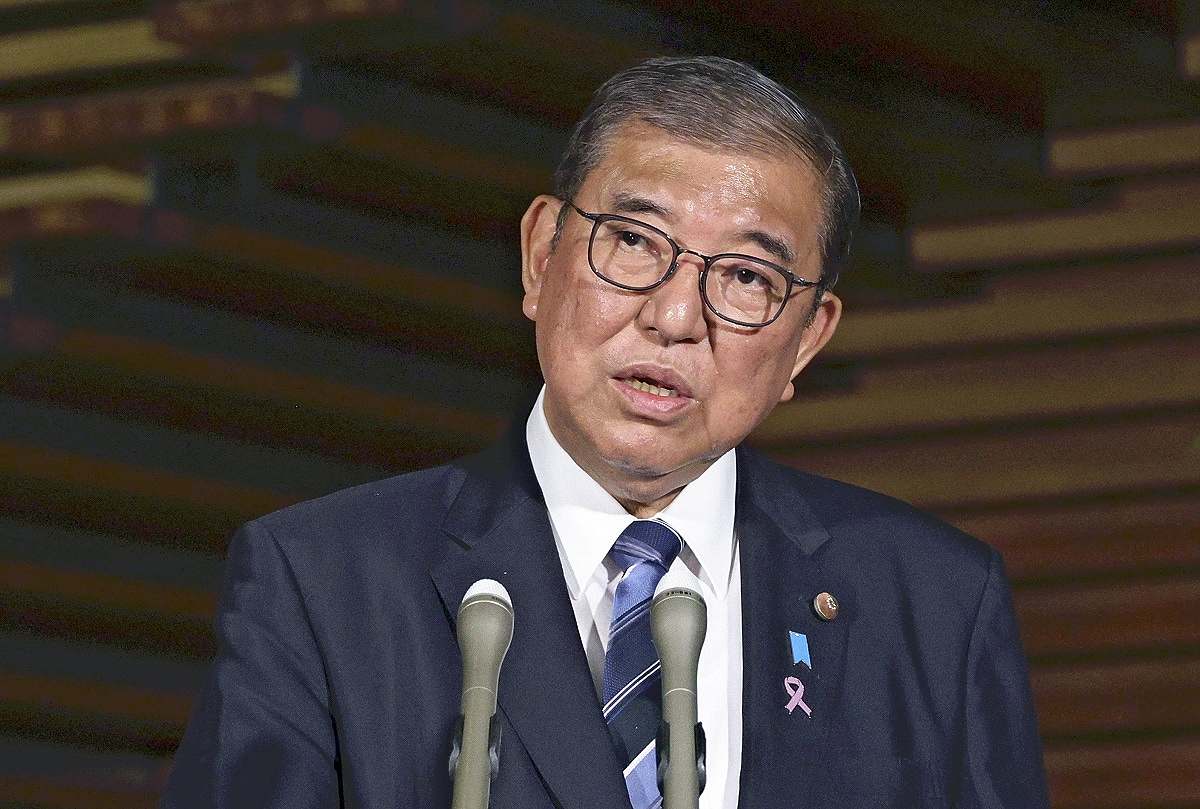New Economic Package Will Further Delay Return of Normal Spending Structure; Subsidies May Impact Decarbonization Efforts

Prime Minister Shigeru Ishiba responds to questions from reporters in Tokyo on Friday.
17:24 JST, November 23, 2024
The new economic package adopted by the government on Friday is to be financed by a supplementary budget, which earmarks around ¥13.9 trillion in general-account spending, greatly exceeding the amounts allocated in fiscal years before the COVID-19 pandemic.
The Liberal Democratic Party and Komeito, the minority ruling parties, now have no choice but to accept the demands from the opposition Democratic Party for the People for income tax cuts and other measures, lighting a warning signal that the restoration of a healthy financial situation will be delayed.
Building up people’s finances
On Friday evening, after the new economic measures were adopted at an ad hoc Cabinet meeting, Prime Minister Shigeru Ishiba emphasized the significance of the package, saying, “In order for people to feel more well-off in their daily lives, it is necessary for households to build up their finances.”
The new economic package has swelled in comparison with a similar one adopted in fiscal 2023, both in the amount of general-account spending in the supplementary budget and its total size, including related spending by the private sector, which were ¥13.1 trillion and ¥37.4 trillion, respectively.
The scale of new economic measures for fiscal 2024 will total around ¥39 trillion.
Within the past couple decades, supplementary budgets have hovered in the ¥1 trillion to ¥5 trillion range each fiscal year, except in times such as when the economy plunged due to the impact of the Great East Japan Earthquake of 2011. In fiscal 2019, a year before the COVID-19 pandemic, it totaled ¥3.2 trillion.
The government has attached importance to putting finances on sound footing. In its Basic Policy on Economic and Fiscal Management and Reform, which was approved by the Cabinet in 2023, it stated it would “return the spending structure to normal.”
However, on the day the House of Representatives election was officially announced in October, Ishiba declared that “a supplementary budget larger than last year’s” would be crafted for the new economic measures.
The reality is that the supplementary budget was formulated on the premise of “its [considerable] scale” even before the content was scrutinized.
Decarbonization efforts
Included in the package are mostly stopgap measures like the ones taken previously, such as subsidies for utility bills, including electricity and gas, and benefits for low-income households.
The electricity and gas subsidies began in January 2023 and ended in May this year. But they resumed from August to October on the premise that they would help deal with the extreme heat.
The subsidies are to be granted from January to March next year as “the period of the highest usage of electricity by households.”
The gasoline subsidies, which began in January 2022, have also been extended time and again but were supposed to conclude at the end of this year. However, they will continue into 2025.
The total expenditure to date, when these subsidies are combined, has exceeded ¥11 trillion, with the additional amount earmarked in the new package expected to exceed ¥1 trillion.
“The current support may distort the pricing mechanism and diminish energy-saving enthusiasm, thereby running counter to decarbonization efforts,” said Yoshiki Shinke of the Dai-ichi Life Research Institute.
The government has also spelled out huge public support totaling more than ¥10 trillion over several years for the artificial intelligence and microchip sectors.
The question remains regarding how deep the government should get involved in supporting specific companies such as Rapidus Corp. which aims to domestically produce cutting-edge microchips.
Primary balance at risk
Except for the support for semiconductors and the like, no specific financial resources have been shown for the new economic package, which will make it necessary to issue additional government bonds, raising concerns about its impact on fiscal soundness.
According to government estimates made in July this year, the primary balance of the national and local governments was expected to move into the black in fiscal 2025.
However, the surplus is expected to be only ¥800 billion. The execution of some of the new economic measures has apparently been delayed until fiscal 2025, while the tax revenue of both the national and local governments is expected to drop due to the planned hike of the minimum annual taxable income from ¥1.03 million.
A senior Cabinet Secretariat official voiced on Friday that “it has become difficult to get it [the primary balance] into the black in fiscal 2025.”
"Politics" POPULAR ARTICLE
-

Japan to Support Central Asian Logistics Route That Bypasses Russia, Plan to Be Part of Upcoming Summit in Tokyo
-

Japan to Tighten Screening of Foreigners’ Residential Status by Providing Information of Nonpayment of Taxes
-

Chinese, Russian Bombers Flew Unusual Path by Heading Toward Tokyo; Move Likely Meant to Intimidate Japan
-

Japan Plans National Database to Track Foreign Ownership of Real Estate, Land as It Weighs New Rules
-

Up to 199,000 Deaths Estimated From Mega-Tsunami; Most Recent Occurrence Took Place in 17th Century
JN ACCESS RANKING
-

Tokyo Economic Security Forum to Hold Inaugural Meeting Amid Tense Global Environment
-

Keidanren Chairman Yoshinobu Tsutsui Visits Kashiwazaki-Kariwa Nuclear Power Plant; Inspects New Emergency Safety System
-

Imports of Rare Earths from China Facing Delays, May Be Caused by Deterioration of Japan-China Relations
-

University of Tokyo Professor Discusses Japanese Economic Security in Interview Ahead of Forum
-

Japan Pulls out of Vietnam Nuclear Project, Complicating Hanoi’s Power Plans






















